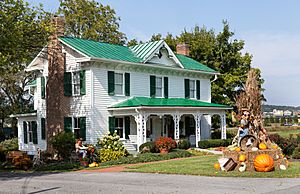Lewis Buckner facts for kids
Quick facts for kids
Lewis Buckner
|
|
|---|---|
| Born | March 12, 1856 |
| Died | May 16, 1924 (aged 68) |
| Occupation | Carpenter |
Lewis Buckner (born March 12, 1856 – died May 16, 1924) was a talented American house builder. He was also a skilled carpenter and furniture maker. His name is sometimes spelled "Louis Buckner."
Lewis was born into slavery as a child. He gained his freedom in 1865. Later, he learned how to make furniture. Buckner became one of many successful African-American builders. He worked in Sevier County, Tennessee in the late 1800s.
At least fifteen homes built by Buckner are still standing today. Two of these homes are even listed on the National Register of Historic Places. This is a special list of important historical places in the U.S. Buckner also designed and built beautiful furniture. In 2015, the Tennessee State Museum bought a fancy bed and dresser he made.
Lewis Buckner's Life Story
Lewis Buckner was born in Strawberry Plains, Tennessee in 1856. His mother was an African-American slave. His father is thought to have been white. Lewis and his mother became free in 1865. This happened after the American Civil War ended.
In the 1870s, Lewis learned a special skill. He became an apprentice to Christian Stump. Stump was a white furniture maker in Sevierville, Tennessee. This is how Lewis learned to build furniture.
Lewis married Jane Bryant in 1875. By 1880, he had started his own business. He made and sold cabinets. The Tennessee State Museum bought some of his furniture in 2015. These pieces included a detailed bed and dresser from around 1889.
With his amazing skills, Buckner started bigger projects. He built his first house around 1880. It was called the Darius and Mary Robertson House. He built many other homes too. These included the Wayland-Patterson House (1886) and the Riley H. Andes House (around 1890). He also built the Trotter-Waters House (1895) and the Sam Dixon House (1914). One of his last known homes was the Mullendore House (1921).
In 1894, Buckner built his own house. It was in the Mullican Grove community. He also worked with Isaac Dockery, a bricklayer. Together, they helped build the New Salem Baptist Church in Sevierville in 1886. Dockery built the brick walls. Buckner designed the inside of the church.
How Buckner Designed Homes
Lewis Buckner was a creative builder. He often used special design books for ideas. But he didn't just copy them. He changed the basic plans to make his own unique designs.
Buckner's houses often had two stories. They were usually in the Italianate or Queen Anne styles. These styles were popular at the time. He often carved and built many parts of the houses himself. This included fancy details on the outside. He made things like bargeboards, porches, and decorative scrollwork. Inside the houses, he also crafted mantels, cabinets, and newell posts (parts of staircases).
Homes Built by Lewis Buckner
Many homes in Sevier County are believed to have been built by Lewis Buckner. At least fifteen of them are still standing. Some of these homes are known through family stories. Others are recognized because they look very similar to his known works. Two of his documented homes are listed on the National Register of Historic Places.
Here are some of the houses Buckner built or worked on:
- Riley H. Andes House: This house is on Douglas Dam Road in Sevierville. It was built around 1890. It was added to the National Register of Historic Places in 1980.
- Sam Dixon House: Built in 1914 near the Shady Grove community.
- William Cal Jones House: Built around 1886 in the Fair Garden community. People usually say Buckner built this one.
- Lafollette-Patterson House: A two-story house in the Fair Garden community, east of Sevierville.
- Mullendore House: Built in 1921 near Pigeon Forge.
- Darius and Mary Robertson House: A two-story house built around 1880. It is in the Harrisburg community outside of Sevierville. Buckner did most of the original inside design work for this house.
- Trotter-Waters House: Located at 217 Cedar Street in downtown Sevierville. It was built in the Queen Anne style around 1895. It was added to the National Register of Historic Places in 1975.


